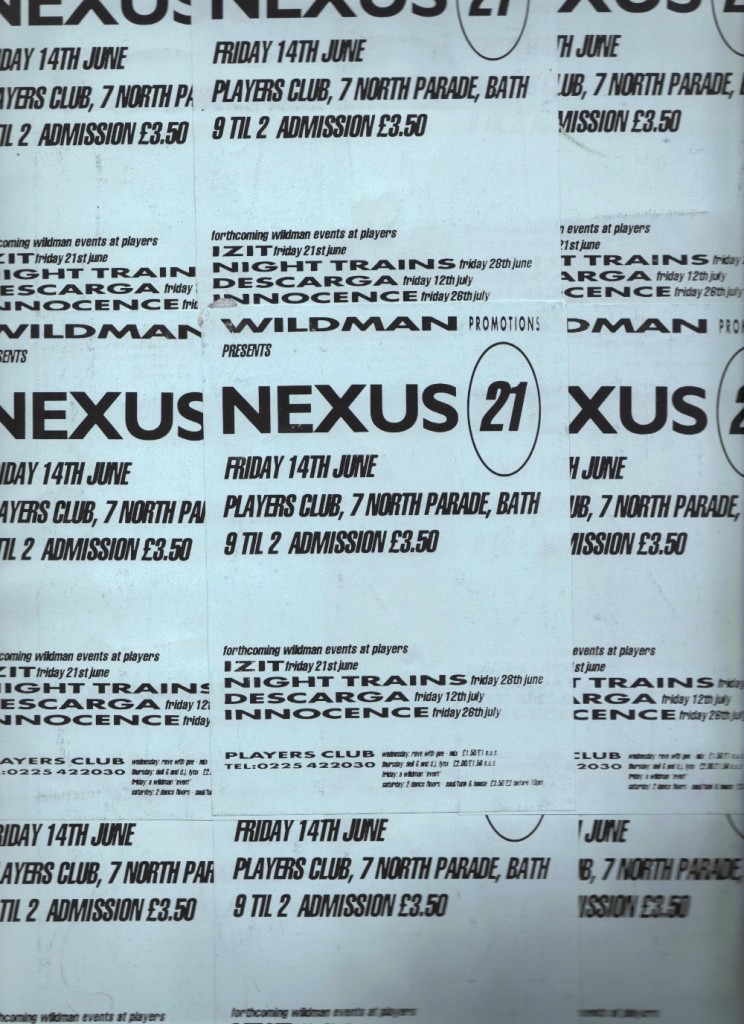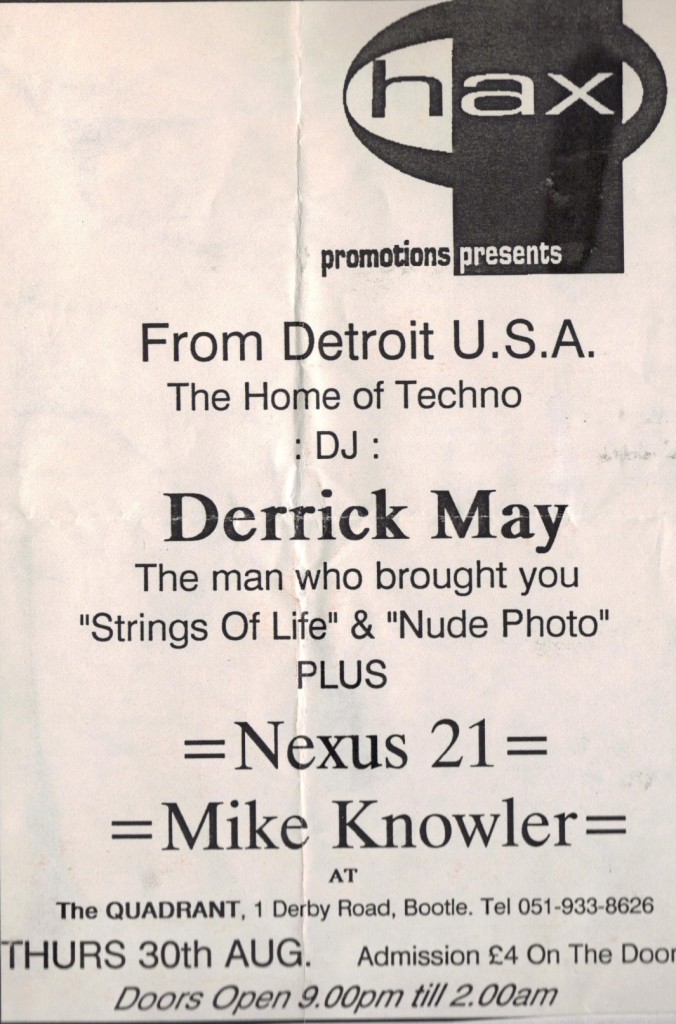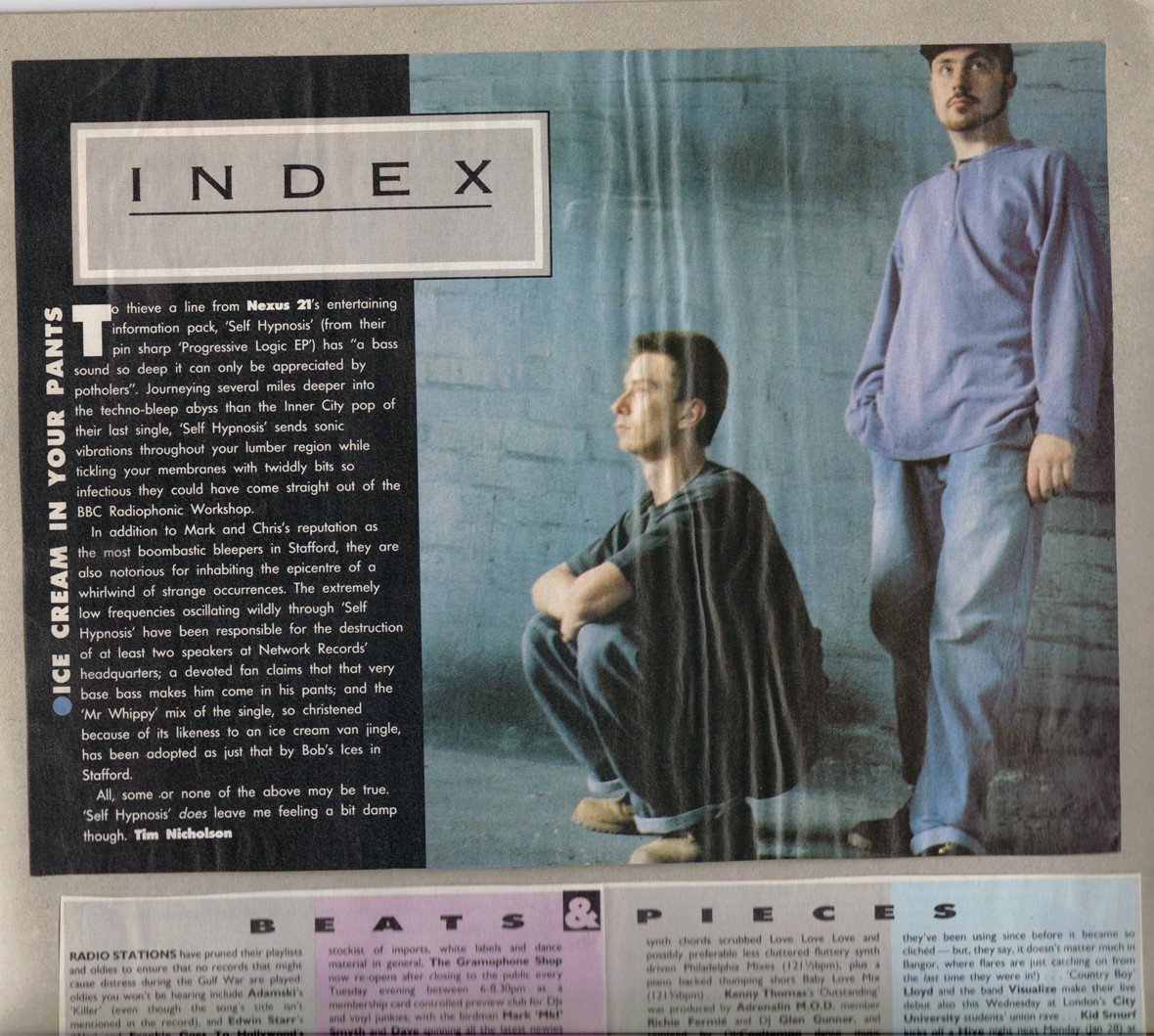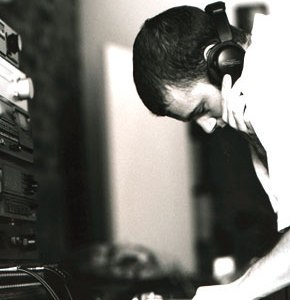In the beginning there was jack, there was also a duo from Stafford called Nexus 21
For the uninitiated, the dynamic duo of Mark Archer and Chris Peat (better known to many as Altern 8) hail from Stafford in the Midlands, UK. They first teamed up together to record a string of projects for the long defunct label Blue Chip – initially forming as Nexus 21 in 1989 with a brief spell as C&M Connection.
After only one 12” release “Another Night”, they gave up the C&M name and continued with Nexus 21, putting together a string of releases that would help define the evolving sounds of a whole new beat this side of the Atlantic in the shape of Techno. Although their output went on to be eclipsed by their chart busting rave act, it’s easy to overlook their contribution to the emerging sounds of electronic music as it resonated from post-industrial hives on both sides of the pond. Their first release as Nexus 21 was “(Still) Life Keeps Moving”, a vocal led piece of stomping stab heavy dance floor fuel, fitted the mould as etched by American contemporaries Inner City, which quickly became an early day classic in its own right.
Followed up by their sole LP “The Rhythm Of Life”, the duo were strongly influenced by the music emanating from Detroit alongside the ever present beat of acid house and electro. After the release of their album, Blue Chip folded. However, Mark and Chris were fortunate enough to be snapped up by the newly founded Network Records, also a Midlands based enterprise. With R&S signing “Logical Progression” and “Techno City” for release as a full 12”, Detroit was soon calling next with the mighty KMS licensing a set of remixes of “(Still) Life Keeps Moving”, which included Carl Craig, MK and Kevin Saunderson all lending a hand on remix duties.
The deep techno of “Self Hypnosis” is arguably one of Mark and Chris’ finest productions, conceived as a contribution to the Bio Rhythm “Music With Bleeps” compilation released in 1990. Although a second Nexus 21 album was ready in late 1991, due to problems with sample clearance, it never materialised. When successive EPs under the name of Altern 8 took the rave scene by storm, the rest became history and the name Nexus 21 then only got used for occasional remixes. With so much attention being paid to the rave outfit, it felt like the time was right to converse with Mark and chat about those very early days and get a better sense of what it meant to be part of such an exciting era in dance music.
What was your background in music initially then?
“Up until I was about 10, I was pretty much into anything that I liked, no particular style, just what was on the radio. When I turned 10, my family moved house and you had to like heavy metal at the school I went to! Otherwise, you’d get beaten up more by the bullies there so after a year or so of buying heavy metal, I started getting into the whole 2 tone/ska thing and then a bit of the new romantic stuff. It was when someone turned up at school playing electro that I knew this was it. I was mad into all the early electro funk and all the 80’s boogie stuff, which then kind of lead on to hip hop and house. I followed that right through the rave scene really.”
How did you and Chris meet?
“Myself and Dean Meredith had been recording stuff together but neither of us were that great playing keyboards so the studio (Blue Chip) put an advert in the local paper and Chris and Andrew (Meacham) turned up. I didn’t know him from school and he wasn’t into the house scene at all!”
To many people, Stafford hardly seems like a hotbed for Detroit influenced Techno – how did you find yourselves getting exposed to the sounds emerging from the USA?
“I used to listen to a lot of 80’s boogie etc. on the local network radio and buy the Streetsounds albums, and then a few bits of house were starting to get played at local clubs. I’d go to Birmingham and scour the record shops there and I’d listen to Jeff Young on a Friday who used to play a real good cross section of dance stuff.”
What clubs/parties were happening in Birmingham at that time?
“I went to a lot of places in Stoke mainly, Frenzy was the first acid house night I went to back in 88 but as with most towns, I guess the police were reacting to government guidelines and were closing things down, so that didn’t last too long. Then there was a night at Jowell’s (that later became the Void where Golden was held), then there was a night in Central Park up the road in Newcastle-Under-Lyme, and Introspective in Longton. I also went to a place called Number 7’s in Burntwood where I met Neil Rushton from KoolKat/Network Records and a night at the Dome in Birmingham in 1990 (that was on a Wednesday). All of them were very influential, especially Number 7’s.”
Is it fair to say you were ahead of the curve – were you massively aware of what was going on in say Sheffield, Leeds, Manchester at the time or did the Midlands pretty much do its own thing?
“I didn’t think we were ever ahead of the curve and weren’t part of any local or regional scene, we were stuck in Stafford doing what we wanted to do. As there was no internet back then, unless you went to a place you had no idea what was going on there, so it wasn’t until there were all these bleeps and bass tunes coming out that I knew anything was going on up in Sheffield. I always went clubbing in Stoke and it wasn’t even a Midlands thing either!”
Did you go to the infamous Shelley’s?
“I really started to go to Shelley’s in 1991 but had been a few times before that, but Stoke was the closest place to Stafford that had a scene. I’d been going up to Stoke since the break dancing days so knew a few people, and they had a couple of good underground record shops. Shelley’s kind of followed on from Introspective, which was at the Leisure Bowl in Longton. Top venue! It had a sprung floor so it was well bouncy and it was really dark. Proper tunes all night and a wicked buzz, then when Shelley’s came along (it was pretty much round the corner), it was very similar but you had a sense of being part of a family in there. Everyone had their own place where they danced, you’d always get 2 pints of water at the bar so you could offer one round on your way back to where you were dancing, it was that kind of vibe.”
 What was the story behind Blue Chip – how did you get involved with engineering and releasing music with them?
What was the story behind Blue Chip – how did you get involved with engineering and releasing music with them?
“We (myself and Dean) had done a few demo tracks on a pair of decks and a Casio SK1 sampler and taken them to the newly opened studio. The studio owner signed us up there and then. Once we got in the studio, the owner just wanted us to copy what was in the charts at the time, stuff like Bomb The Bass etc. We engineered a lot of the dance stuff that came into the studio with other artists as well as all our own material: like the Acid and Breakbeat LPs we did, ‘Rhythm Mode D’ and the first ‘Bizarre Inc’ album.”
You went on to produce and write and impressive amount of music in the early days – do you think it was a simple reflection of the excitement and energy of the era or did you simply have your head down and got on with it?
“It was definitely the excitement and naivety of the early days, getting used to the equipment as well as being into so many different styles of dance music at the time; wanting to do a bit of everything. The acid album that we did was just by Dean and myself but we made it look like a compilation by up and coming producers. We used 6 different artist names. Basically, we were in the studio 5 days a week (sometimes 6), so whenever we had an idea for a track we just went with it.”
What was the actual first bit of production you and Chris teamed up on?
“It was the very 1st Nexus 21 track we recorded, Techno Symphony. He wasn’t into the music or the scene at all, so I used to go in the studio with a pile of records and play a few things to him. Then I’d say I’d like a bassline similar to something, he’d jam out a few riffs until something good came along and I’d adjust it by saying it needed to go up at the end, or loop around in a certain place.”
You initially founded Bizarre Inc with Dean Meredith and produced the first album – what was the story behind that?
“We had recorded hip hop, acid house and done Breakbeat albums together as well as remixing tracks for other people, so we wanted to do a more kind of Mr Fingers/Baby Ford kind of thing and decided to do a new project. Bizarre was a word all our mates were using at the time, so that became the name and we recorded the 1st album ‘Technological’ and then the 1st 12″ Technological/It’s Time To Get Funky. Then, Dean decided he wanted to go solo, so got me the sack from my job at the studio.”
How did you and Chris progress to founding C&M Connection then?
“It was another one of the studio owner’s ideas of doing something similar to a record that was in the charts! Black Box were big at the time and he said we should do an Italian piano track. So, we recorded the track, came up with another pseudonym and then did a Nexus 21 techno mix for the b-side (which was later renamed Biorhythms on Network).
As Nexus 21, you really seemed to hit your stride– did you initially have plans to run with the project and see where it would take you?
“We never had any plans, never knew how long anything would last, we were just winging it all the way! Altern 8 was just a side project and so was C+M Connection. Nexus 21 was definitely our main project but after recording the 1st album on Blue chip, we didn’t really have any other plans. It was only when we signed to Network that they really got involved and sent us to Detroit to work in the studio with Kevin Saunderson, Anthony Shakir and Marc Kinchin. Believe you me, I was literally speechless for a week.”
 That literally must have been a whole other experience for you both!
That literally must have been a whole other experience for you both!
“I was well into Detroit techno then and had a lot of the records already, so going out there and meeting my musical heroes was proper mad (Chris wasn’t into the music or the scene at all so had no idea who they were). We did a live gig there alongside Inner City, hung out at Kevin’s house with him and his family and also had a BBQ at Derrick May’s. I was totally star struck all the time and couldn’t believe what was going on!”
You released on both Network & R&S, did you get approached by other labels for material?
“To be honest, once we were signed to Network, I didn’t even consider recording for anyone else, but we weren’t even asked. I think because peoples contact information wasn’t that easily available like it is now, no one knew how to get in touch, or maybe they weren’t that interested! The licensing deals for R&S and KMS were done through Network though and I’m really proud to say I had releases out on all three of the labels. Granted, a Transmat and Metroplex release would have been nice too.”
Your second album got shelved in the end due to sample clearance – are you glad looking back?
“We were about three quarters of the way through the album and pressed up the 1st single ‘Know we can make it’ and got hit because of the vocal sample. They wanted pretty much all the publishing and royalties off the track, so the label decided to pull it as it was to be one of the main tracks on the album. Looking back, it was a good idea as it wasn’t maybe as pure as the 1st album and had far too many different influences. Still, we made had some boss tracks though.”
Do you think some of that unreleased material might end up seeing the light of day?
“I have no idea, but there was some stuff that was recorded in Detroit in 1990 that has never seen the light of day, I’d love to see get released one day.”
At what point did you realise you were destined for much bigger success with Altern 8?
We never really knew how any of the early Nexus 21 tracks were going down or how they sold as the label kept that info from us. When the Altern 8 tracks started getting played in a lot of the clubs I was going to and we were doing loads more live gigs. The next thing we knew, Infiltrate 202 had a top 40 chart position. That’s when I thought it was going somewhere! I never could I have imagined I’d be lucky enough to still be doing this 26 years later.”





